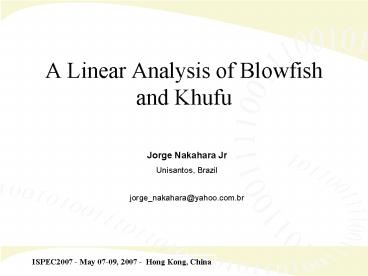A Linear Analysis of Blowfish and Khufu PowerPoint PPT Presentation
1 / 18
Title: A Linear Analysis of Blowfish and Khufu
1
A Linear Analysis of Blowfish and Khufu
Jorge Nakahara Jr Unisantos, Brazil jorge_nakah
ara_at_yahoo.com.br
2
Outline
- The Khufu and Blowfish Block Ciphers
- Linear Cryptanalysis
- Linear Attacks on Blowfish
- Linear Attacks on Khufu
- Conclusions
3
The Khufu Block Cipher
- Block cipher with Feistel Network structure
- Designed by R.C.Merkle in 1989
- 64-bit blocks (plaintext/ciphertext)
- Variable-length key up to 512 bits
- 8r rounds (1 r 8), where r is called octet
(originally r 2 was suggested) - One key-dependent 8x32-bit S-box per octet
4
The Khufu Block Cipher
5
The Blowfish Block Cipher
- Cipher with Feistel Network structure
- Designed by B. Schneier in 1993
- 64-bit blocks (plaintext/ciphertext)
- Variable-length key 32 bits up to 448 bits
- 16 rounds
- Key-dependent 8x32-bit S-boxes and a P-table
6
The Blowfish Block Cipher
7
Linear Cryptanalysis
- Developed by Mitsuru Matsui (Mitsubishi Corp.)
- Initially applied against DES (1990), FEAL-4 and
FEAL-8 (1989) - Known-plaintext (KP) attack setting
- Distinguisher tool linear relation involving
plaintext, key and ciphertext bits with
non-uniform parity (away from ½) - (nonzero) bias of linear relations
8
Linear Cryptanalysis
- number of known-plaintexts for high success rate
attack is proportional to bias-2 - general attack technique (applied to block and
stream ciphers) - variant techniques differential-linear, multiple
linear relations, linear hulls
9
Linear Attacks on Blowfish
- - unlike previous DC, our LC attacks do not
require the S-boxes to be non-injective mappings - - 8x32-bit S-boxes are key-dependent, but always
non-surjective mappings - we exploit linear relations of the form 0??
across the S-boxes, where ? is a non-zero bit
mask. - we choose ? 1 due to mixing of modular addition
and exclusive-or in the round function,
10
Linear Attacks on Blowfish
- exploit the least significant bit positions (to
avoid decreasing the bias due to carry and borrow
bits) - extend linear relations to full rounds, and to
multiple rounds iterative linear relations - we have found 2-round iterative linear relations
- construction of the linear distinguishers was
heavily influenced by the design of Blowfish
11
Linear Attacks on Blowfish
- we derive one-bit of information on the
key-dependent P-table - (L0 L2t).1 (P1 P2 ... P2t1).1
- (R0 R2t).1 (P2 P4 ... P2t).1
- where (Li, Ri) are the left and right halves
of the - i-th round block, and is xor.
12
Linear Attacks on Blowfish
- the bias of linear relations depends on the key
since the four S-boxes are key-dependent weak
(user) keys
13
Linear Attacks on Khufu
- 8x32-bit key-dependent S-boxes
- again, S-boxes are non-surjective the bit mask
has the form 0??, with ? non-zero - bit-rotation in each round is by a multiple of 8
bits - this fact inspired rotation-invariant bit masks
? ltltlt 8t ?
14
Linear Attacks on Khufu
- thus, the masks do not change if they are rotated
by 8-bit amounts (in either direction) - more precisely, ? mmmm, m ? ?256
- we have looked for iterative linear relations
- we have found 2-round and 8-round iterative
linear relations for rotation-symmetric masks
15
Linear Attacks on Khufu
16
Linear Attacks on Khufu
- ciphertext-only (CO) attacks exploit linear
relations of the form 80000000x, 00800000x, ....
80808080x and assuming the plaintext is ASCII
text. - CO attack is possible because of exclusive-or
(diffusion is poor!)
17
Conclusions
- linear attacks on Blowfish and Khufu
- weak-key assumption (distinct from DC attack
assumption) - old, known attack technique on old ciphers,
- but new and better (known-plaintext and
ciphertext-only) results, compared to previous
attacks (DC, ID) that worked in a
chosen-plaintext setting.
18
Conclusions

